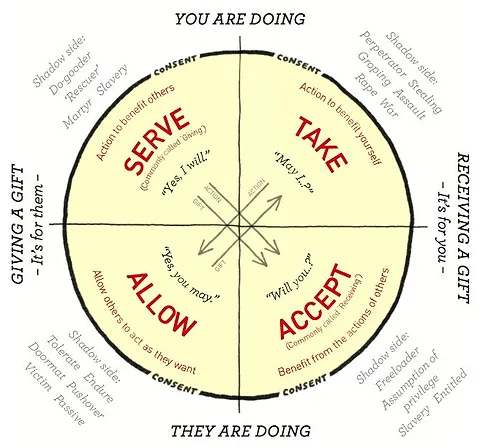Beyond the Bedroom to True Connection
Sexuality! When you see that word, what do you think about? Having sex? Sexual preferences – as in being gay or straight? Fancying someone? Do you ever associate sexuality with how you access your own feelings, with consent or boundaries or with how you communicate? Chances are, not so much. We aren’t really taught these skills unless we go out to look for them. Sexuality and intimacy are subjects that we don’t talk about much but they are a hugely powerful aspect of our health. Healthy sexuality can bring self fulfilment and in loving, intimate relationships it can bring joy and deep love and connection. A lack of it can cause infidelity, breach of trust, addictions and even chronic disease.
We all have our own relationship with either ourselves, our partners if we have one, we all have a past, we have fantasies, ideas, we lust and long or maybe we have shut down and given up.. wherever we are, there is a relationship going on. A lot of the way that we operate within our sexuality is unconscious. It’s a complicated issue, we are all different and complex beings.
We all have a need for connection to others and for healthy self expression. According to Maslow’s hierarchy of needs, sex is a fundamental physiological need, right at the bottom of the ladder with food, shelter and safety. Further up this hierarchy come other aspects of sexuality like love, acceptance and belonging. Given that opening up to our feelings requires fundamentally, honesty at least with ourselves and then perhaps vulnerability to share that openly with someone else, it takes courage to connect. Connecting to ourselves requires us to feel what arises in us, our rhythms, what flows through, into and from us and it also requires us to be present for our partner when they have the courage to do the same. If we don’t experience this connection to ourselves we can experience:
Anger, Sadness or Depression, Jealousy, Anxiety or Emotional coldness/disconnect.
It is said with libido that if you don’t use it, you will lose it… So how do you rekindle that flame if it’s going out with your partner or how do you get in touch with it when it’s dormant in yourself?
I have written a serious article about the nutritional aspects of hormone synthesis and metabolism on my other platforms but here I want to take a dive into both the practical and creative aspects of sexuality, more tantric and hopefully for you lovely readers, more inspiring, to bring joy and connection into your personal lives and relationships.
There is a lack of connection in modern society, to self & to others.
If we aren’t connected to ourselves then how can we connect to our significant other. When we think about masturbation for example, it still has that ‘dirty word’ edge to it. There are loads of initiatives over the last few years to break through these taboos though… a lot of work has been done and is continuing to help women and men understand how to have pleasure and intimacy in their relationships.
We generally live in a conservative society in Europe, where porn is generally something that is something people watch alone, behind closed doors and don’t talk about much. Porn is often used in an addictive way and is a poor substitute to fill the emotional/physical space that a lack of true connection creates. There is a reason why according to Gitnux.org around 25% of all search engine requests is for porn (1). Other statistics put this figure much higher. There is a lot of desperation and loneliness out there, a lot of sadness and disconnect.
So, how do we start a small revolution in our own private worlds?
Well, for starters I recommend the site OMGYes which is a great resource for men and women both solo and in couples, to understand masturbation and female pleasure. On this site there are videos and articles where many women talk about how they masturbate, what feels good for them and how they do it. It’s fascinating to learn how we are all so different and that actually what we thought might have been something to be ashamed of or something we daren’t ask for is actually something that many other women and couples enjoy and is totally normal. It allows women (and men) to understand the vast range of what is actually completely healthy behaviour and to explore that in a meaningful and open and hopefully fun way. I am absolutely all for breaking down these taboos and the pursuit of pleasure, love, self-fulfilment and connection. Whatever brings couples and people together and brings joy, means more overall joy in the world.
Betty Martin continues to do some great work around the world with her Wheel of Consent which gives quadrants and opposites in communication and specifically to consent, here is her diagram. (With permission from and thanks to Betty Martin)
There is a lot to learn here and Betty offers her ‘Like a Pro’ training to all those who work with touch, like massage therapists, physical therapists and bodyworkers. Betty Martin did review this article and suggested that I inform you that she offers weekend workshops around the world for people with certified facilitators and you can access them by using this link.
It’s important for everyone to understand the basics of boundaries and consent. Usually most people only discover their boundaries once the line has been crossed and often the setting where the boundary being crossed is a tricky one to assert and come back from. Ideally, we would learn how to carefully feel into where our boundaries might be so that we know when a situation gets close to that line and we can back off. Learning how to say no and also to take a no, is another very important aspect and falls in line with the open communication which is so important for connection too. We can learn how to do that with exercises like the Corridor game which goes something like this.
Stand in a corridor with your partner. Far away from each other. One of you start and beckon the other towards you… they have got to move very, very slowly towards you and you have to beckon them to you or push them away, just with your hand movements so that they know whether to keep advancing or retreating. The partner controlling the movement needs to feel into the closing or opening space between partners and notice how that makes them feel… moving too fast will be too confusing so it has to be super slow and the idea is that you would notice where the dynamic or feeling shifts as the distance changes… this will allow you to get in touch with the feelings that move when you get close to your own boundaries being crossed. Then swap who is in charge. It’s a great way of learning how feelings can shift in a moment and how they can go back to feeling safe when the distance changes. See what it brings to you.
Dynamics are so important, not just in sexuality, but in everyday life.
You may find it interesting to learn that sometimes when men think they are ‘giving/serving’, women think they are ‘allowing’. What does that say about the dynamic if women are putting men in the position of taking, when they think they are serving? As women, how can we learn to receive or accept the gifts that our loving partners provide us with, thereby deepening the bond between us and building gratitude, reciprocity if it’s right and proper understanding. This is where the ‘conscious’ aspect of conscious sexuality comes in. Perhaps we need to start having a conversation about boundaries first, in a practical way, at least discussing the different quadrants that Betty Martin offers us and how that might manifest for each person. It all starts with communication. We could play around with asserting boundaries in a safer way and that actually starts with feelings and self connection. It’s worth trying these practises and talking about feelings, getting the lines of communication open so that we raise our own awareness about how it feels when someone gets close to a boundary, crucially before it is crossed which could lead to a shutting down, disconnect and deepening of the divide between partners.
There is a lot of scope to play around with the dynamics too, which can be a lot of fun between partners. You Accept, while I Serve (and you aren’t allowed to give back while I serve), or I will Take (from you), while you Allow… you can see how interesting that could get.
These are all big subjects but it doesn’t have to get complicated. Betty Martin offers her 3 minute exercise game which can be a great way to start between partners.
You could even do this with a friend if you are single, to get comfortable and it’s probably better to start off without including sexuality as such even between partners. It’s more a way to get comfortable with what kind of touch you actually like, how to say no in a way that feels comfortable for you, how it feels to be told that the way you are touching is wrong and so on and how you move on from that.
With your partner there can sometimes be this sense of needing to wait for the ‘right moment’. Consider that you can set an intention instead and make a date, put it in the diary and show up for your partner. It’s a lot easier to agree to interact without expectation of any goal and simply make the agreement to be close in that time for example.
Pressure and expectations can lead to resentment and stepping over boundaries. You might not feel comfortable and that’s OK too, practise setting boundaries safely until you feel comfortable (which might be never and it’s good to know yourself so you can move away from what isn’t right for you).

When we slow right down and start to allow ourselves the space to get in touch with what actually feels OK and not OK for us, we can more easily communicate that feeling to our partner and to equally understand better how our partner is feeling, we open ourselves up to a much deeper connection and hopefully more fulfilling and happy relationships.
Main – Photo by Slav Romanov on Unsplash





